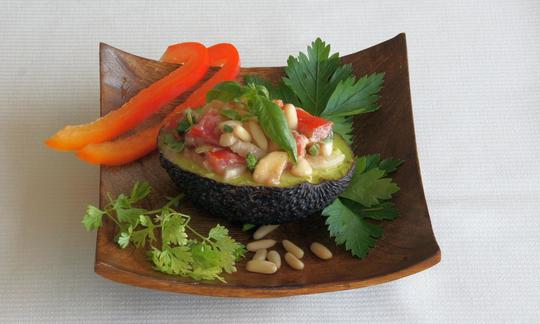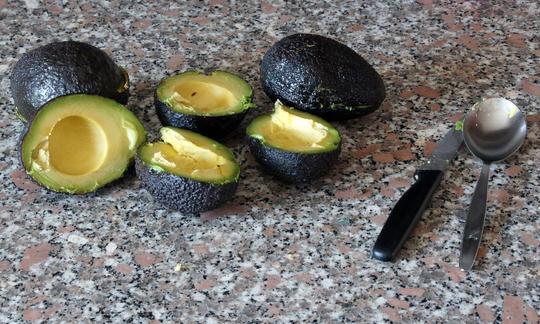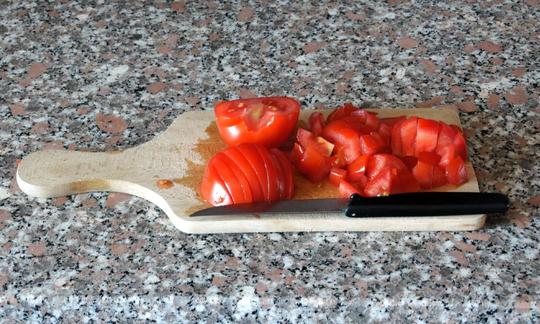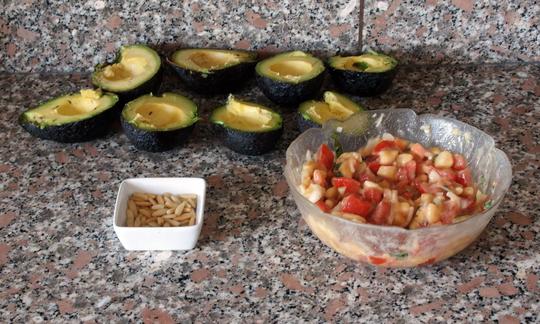Avocado Boats with a Tomato and Banana Filling and Pine Nuts
vegan
Ingredients (for servings, )
| For the avocado boats | |
|---|---|
| 4 | Avocados, raw (organic?) (28 oz) |
| For the tomato and banana filling | |
| 2 | Tomatoes, raw (organic?) (8.6 oz) |
| 1 | Bananas, raw (organic?) (4.1 oz) |
| 5 leaves | Basil, fresh (organic?) (0.09 oz) |
| 1 | Onions, raw (organic?) (3.9 oz) |
| 1 tsp | White almond butter, raw? (organic?) (0.20 oz) |
| 1 tsp | Soy sauce (tamari, organic? raw?) (0.21 oz) |
| Garnish | |
| ⅓ oz | Pine nuts, raw (seeds, organic?) |
Type of preparation
- food preparation without heating
Preparation
For the avocado boats
Cut the avocados in half and remove the pit.Using a spoon makes it easier to remove the pits.
For the tomato and banana filling
Wash the tomatoes and peel the banana. Cut both into small pieces and place in a mixing bowl.Peel and chop the onions. Wash, shake dry, and chop the basil. Add both along with the almond butter and tamari to the tomato and banana filling. Mix well.
If you use a fork to lightly mash the filling, you should be able to achieve a creamier consistency.
Garnish and serve
Spoon the filling into the avocados and garnish with pine nuts. Serve and enjoy.
|
Nutritional Information per person
Convert per 100g
|
2000 kcal | |
|---|---|---|
| Energy | 397 kcal | 19.9% |
| Fat/Lipids | 32 g | 46.1% |
| Saturated Fats | 4.5 g | 22.6% |
| Carbohydrates (inc.dietary fiber) | 29 g | 10.9% |
| Sugars | 7.9 g | 8.8% |
| Fiber | 16 g | 62.7% |
| Protein/Albumin | 6.0 g | 12.0% |
| Cooking Salt (Na:102.4 mg) | 260 mg | 10.8% |
| Essential micronutrients with the highest proportions | per person | 2000 kcal | |
|---|---|---|---|
| Vit | Folate, as the active form of folic acid (née vitamin B9 and | 185 µg | 93.0% |
| Vit | Vitamin K | 51 µg | 68.0% |
| Elem | Potassium, K | 1'296 mg | 65.0% |
| Vit | Vitamin B6 (pyridoxine) | 0.71 mg | 51.0% |
| Min | Copper, Cu | 0.50 mg | 50.0% |
| Vit | Pantothenic acid (vitamin B5) | 3.0 mg | 50.0% |
| Vit | Vitamin C (ascorbic acid) | 33 mg | 42.0% |
| Vit | Vitamin E, as a-TEs | 5.0 mg | 42.0% |
| Fat | Linoleic acid; LA; 18:2 omega-6 | 4.2 g | 42.0% |
| Min | Manganese, Mn | 0.73 mg | 37.0% |
Detailed Nutritional Information per Person for this Recipe
The majority of the nutritional information comes from the USDA (US Department of Agriculture). This means that the information for natural products is often incomplete or only given within broader categories, whereas in most cases products made from these have more complete information displayed.
If we take flaxseed, for example, the important essential amino acid ALA (omega-3) is only included in an overarching category whereas for flaxseed oil ALA is listed specifically. In time, we will be able to change this, but it will require a lot of work. An “i” appears behind ingredients that have been adjusted and an explanation appears when you hover over this symbol.
For Erb Muesli, the original calculations resulted in 48 % of the daily requirement of ALA — but with the correction, we see that the muesli actually covers >100 % of the necessary recommendation for the omega-3 fatty acid ALA. Our goal is to eventually be able to compare the nutritional value of our recipes with those that are used in conventional western lifestyles.
| Essential fatty acids | per person | 2000 kcal |
|---|---|---|
| Linoleic acid; LA; 18:2 omega-6 | 4.2 g | 42.0% |
| Alpha-Linolenic acid; ALA; 18:3 omega-3 | 0.24 g | 12.0% |
| Essential amino acids | per person | 2000 kcal |
|---|---|---|
| Tryptophan (Trp, W) | 0.07 g | 27.0% |
| Threonine (Thr, T) | 0.20 g | 22.0% |
| Isoleucine (Ile, I) | 0.22 g | 18.0% |
| Lysine (Lys, K) | 0.34 g | 18.0% |
| Valine (Val, V) | 0.28 g | 18.0% |
| Phenylalanine (Phe, F) | 0.27 g | 17.0% |
| Leucine (Leu, L) | 0.38 g | 16.0% |
| Methionine (Met, M) | 0.10 g | 10.0% |
| Vitamins | per person | 2000 kcal |
|---|---|---|
| Folate, as the active form of folic acid (née vitamin B9 and | 185 µg | 93.0% |
| Vitamin K | 51 µg | 68.0% |
| Vitamin B6 (pyridoxine) | 0.71 mg | 51.0% |
| Pantothenic acid (vitamin B5) | 3.0 mg | 50.0% |
| Vitamin C (ascorbic acid) | 33 mg | 42.0% |
| Vitamin E, as a-TEs | 5.0 mg | 42.0% |
| Niacin (née vitamin B3) | 4.3 mg | 27.0% |
| Riboflavin (vitamin B2) | 0.31 mg | 22.0% |
| Thiamine (vitamin B1) | 0.19 mg | 17.0% |
| Biotin (ex vitamin B7, H) | 5.3 µg | 11.0% |
| Vitamin A, as RAE | 42 µg | 5.0% |
| Essential macroelements (macronutrients) | per person | 2000 kcal |
|---|---|---|
| Potassium, K | 1'296 mg | 65.0% |
| Magnesium, Mg | 87 mg | 23.0% |
| Phosphorus, P | 150 mg | 21.0% |
| Sodium, Na | 102 mg | 13.0% |
| Calcium, Ca | 45 mg | 6.0% |
| Essential trace elements (micronutrients) | per person | 2000 kcal |
|---|---|---|
| Copper, Cu | 0.50 mg | 50.0% |
| Manganese, Mn | 0.73 mg | 37.0% |
| Zinc, Zn | 1.7 mg | 17.0% |
| Iron, Fe | 1.6 mg | 12.0% |
| Selenium, Se | 1.3 µg | 2.0% |
| Fluorine, F | 18 µg | 1.0% |
| Iod, I (Jod, J) | 1.8 µg | 1.0% |
Avocado boats with a tomato and banana filling is a nice appetizer and/or side that is quick to prepare. Almond butter and soy sauce enhance the flavor.
Pine nuts: Pine nuts grow on wild pine trees. They are harvested manually in a labor-intensive process, which is why they are relatively expensive. Pine nuts taste somewhat like almonds and have a sweet, subtle flavor. They are available year-round.
We don’t consider soy sauce to be raw. Soybeans are generally heated during the production process since they like all other green beans contain the glycoprotein phasin, which is toxic for humans. Phasin inhibits the absorption of nutrients in the intestine, causes hemagglutination (clumping of the red blood cells), and in larger amounts can destroy the intestinal villi. Heating processes (e.g., cooking and roasting) destroy phasin, making soybeans and soybean products such as tofu, miso, and tempeh safe for human consumption. As a result, even unpasteurized soy products are not actually raw, but are instead cooked products that have been “revived” through the process of fermentation.
Bananas: Bananas shouldn’t be stored in the refrigerator as the cold damages their cell tissue and causes them to quickly get brown spots. If you store them in a bowl at room temperature, they will keep for about three to five days. Bananas ripen even faster when stored next to foods that release ethylene, such as apples or tomatoes. A similar procedure is used to make sure the bananas are fresh at time of sale — they are ripened in warehouses with the help of ethylene. Riper bananas are easier to digest than the green ones, but with increasing ripeness the starch content decreases and the sugar content increases.
Almond butter varieties: Instead of white almond butter, you can also use classic almond butter. White almond butter is made from blanched almonds whereas the classic variety is generally made using roasted, unpeeled almonds. As a result, the darker variety has a more intense taste whereas the lighter version has a finer consistency and a milder flavor.
Almond butter is usually steam-treated and not a raw food, unless it is specially labeled as such. However, there are companies that make raw almond butter. You can find these in some health food store and online.
Using avocado pits: Don’t throw avocado pits away. The nutrients in avocados are found not only in the flesh but also concentrated in the pits. You can grate the pits using a grater or finely grind them in a heavy-duty coffee grinder.
Cedar nuts: Depending on your individual preferences, you can also use cedar nuts instead of pine nuts. Cedar nuts have a more intense, slightly spicy flavor and are less expensive
than pine nuts.
Soy sauce: Instead of tamari, you can also use soy sauce (called shōyu in Japan). It is slightly milder in taste and contains soybeans, water, sea salt, and wheat (or rice).
Grated avocado pits: As described in the Tips section, avocado pits contain valuable nutrients. You can add grated avocado pit to your muesli, granola, or smoothies. You can also sprinkle them on top of this dish to give it a subtle nutty flavor.










